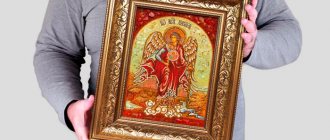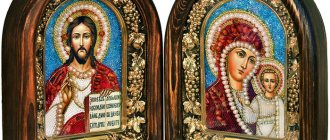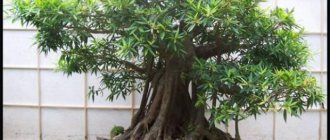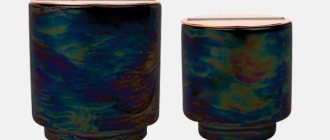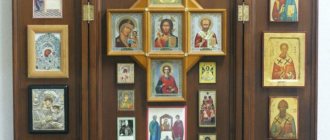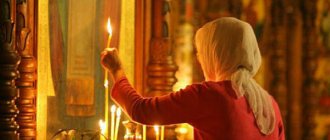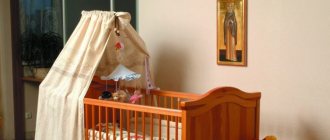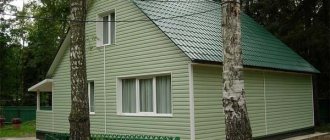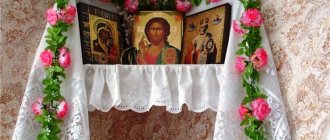Icons are of great importance to Orthodox Christians. A believer, as a rule, has at his disposal several images that are significant to him; this collection grows throughout his life: at birth, at baptism, at marriage, during holidays and memorable dates, during pilgrimages to holy places and many others. cases, the personal prayer corner is replenished.
In this regard, sooner or later the question arises: how should existing icons be stored so that this does not contradict the laws of God? And how to make sure that holy images skillfully fit into a modern interior?
Where can and where can’t you place icons in the house?
Icons in an apartment or in a house will help you maintain a connection with God, as well as receive additional protection.
- It is advisable to place holy images on the eastern side of your house.
- It is not customary to store icons next to worldly books, souvenirs, cosmetics, toys and other items actively used in everyday life.
- The icon can hang on the wall, separate from paintings and photographs. In the nursery, an image of the Guardian Angel or Saint, after whom the child is named, would be appropriate (more details in the section: Icons for baptism). In the kitchen - this may be a common image of the Last Supper. In the bedroom are Saints Peter and Fevronia, protectors of the marriage family. It is also permissible to place holy images in the living room or in any other place.
If there is only one icon, in this case you can use carved frames to frame and decorate the image. And if you have several icons, it is best to place them in a specially designated place. All accompanying church paraphernalia will also fit there.
LiveInternetLiveInternet
Priests answer such questions that the traditional places for icons are: - the eastern wall of any room (by the way, depending on the orientation of the apartment to the cardinal points, it can be either left or right) - the so-called “red front corner” of the living room, t .e. a corner diagonally from the entrance to the living room - where the gaze and movement of the person entering is directed - and in places traditional for Christian prayers: the bedroom for morning and evening prayers (in vain many doubt, marital relations between married people are not a sin), above the doors in the same hallway , for example, to pray before leaving home for work or immediately entering the house, in the dining room - since prayer both before and after meals is common and traditional for Christians, etc. — in the office on the desktop of a believer there is also a place for it, because hanging icons on the walls in work rooms is not always possible. The main complaint from priests is that often icons are in cabinets with secular books, trinkets and other nonsense - this is not good, but you can put an icon on a shelf with spiritual religious literature.( https://forum.ivd.ru/index.php?showtopic=70506&st=0)
“When praying, it is customary to stand facing east; Orthodox churches are built with the altar facing east. Therefore, it is advisable to place the icons on the eastern wall of the room. But what to do if the house is oriented so that there are windows or doors in the east? In this case, you can place the icons in any other accessible place, as it is sung in Psalm 112, “from east to west praise the name of the Lord.” The main thing is that there is enough free space in front of the icons, so that the worshipers do not feel crowded when praying together. Some people arrange a red corner above the bed - this way the cramped space is used more effectively, cabinets and windows do not interfere, and you sleep under the shadow of shrines. You can place the icons on a special shelf, and if there are a lot of them, hang them on the wall, following a few simple rules. For example, if icons are hung haphazardly, asymmetrically, without a thoughtful composition, then this causes a constant feeling of dissatisfaction with their placement, a desire to change everything, which very often distracts from prayer. Icons can and should be placed in other rooms. The icon should also be in the kitchen. There must be a holy image in the children's room (for example, an icon of the Guardian Angel or an icon of the Heavenly Patron of the child). According to tradition, it is customary to hang an icon of the Intercession of the Blessed Virgin Mary above the entrance to a house or apartment. Although it could be any other icon or cross. *** In this case, icons must be placed in a place separate from other objects. Icons look extremely inappropriate in bookcases where secular books are stored, on shelves next to cosmetics, photographs of loved ones, toys, and figurines. You should not place posters of pop performers, politicians, athletes and other idols of the current century near icons. There should not be any artistic paintings among the icons, even those painted on biblical subjects. A painting, even if it has a religious content, such as “The Appearance of Christ to the People” by Alexander Ivanov or “The Sistine Madonna” by Raphael, is not a canonical icon. https://zograf.ru/ikona_v_dome.htm#2)
Hieromonk Job (Gumerov) answers
:
Since ancient times, Christians have prayed to the east. St. Basil the Great writes about this. The theological explanation for this is given by St. John of Damascus: “We worship to the east not simply and not by chance. But since we consist of visible and invisible, i.e. spiritual and sensory nature, then we offer double worship to the Creator, just as, (for example), we sing with both the mind and the bodily lips, we are baptized with water and the Spirit, and we unite with the Lord in two ways, partaking of the sacraments and grace of the Spirit. So, since God is spiritual light
(1 John 1:5), and Christ in Scripture is called
the Sun of righteousness
(Mal. 4:2) and
the East
(Zech. 3:8), then the east should be dedicated to worship Him.” For this reason, it is customary to arrange a red corner and place icons on the eastern side of the house. If the layout of the room or other reasons do not allow this to be done exactly, then you need to choose the wall or corner closest to the east. Following this pious tradition, we should not absolutize it. Some icons can be placed on other sides of the house, so that the sight of holy images maintains a constant mood of prayer in us. (https://www.pravoslavie.ru/answers/6639.htm)
Choosing a place for a personal prayer corner:
A prayer corner is a kind of your own “piece” of the church, where you can be alone with God, pray to him, thank him for what you have, ask for what you want, or pray for the atonement of sins. First of all, to create such a corner, you need to choose a suitable place - quiet, low-traffic, not burdened by technology and inappropriate decor.
Since the times of Ancient Rus', Christian believers have had a tradition of decorating their home with the so-called “red corner”, in which icons and containers with holy water, candles and lamps, prayer books and memorials, and Orthodox crosses are located.
The icons themselves in the red corner can be stored in three main ways: on shelves, in icon cases, or directly in ready-made iconostases. As a rule, the choice of one or another storage method is determined by the availability of free space in the house and, of course, the number of existing icons and other church paraphernalia.
Both in the temple and in the house, icons serve primarily for prayer, so they should be in a place of honor in your home. As a rule - on the eastern wall, but this is not a strict condition.
In the houses of our grandparents, icons occupied the so-called red corner - the place where the eye first falls upon entering. Today, the home iconostasis is positioned depending on the layout of the apartment and the placement of furniture.
Note that icons can be located in absolutely any room - in the living room, in the hallway, in the kitchen. Exceptions are the bath and toilet. Sometimes spouses ask priests whether it is possible to keep icons in the bedroom. Of course, it is possible, because marital intimacy is not a sin. It is considered undesirable to place images of the Savior, the Mother of God or saints next to images, photographs, drawings or posters of other content. Especially with posters of movie or pop stars. Cabinets for books or dishes are also not the best place. An icon is not some kind of souvenir, it depicts the faces of saints and reminds of their lives, so it is undesirable for people to constantly fuss in front of the images, move cups and plates from place to place, take out books or rearrange cosmetics. The place for a home iconostasis should be calm.
You can keep just a couple of icons at home, for example, in the living room and kitchen. After all, you also need to pray before and after meals.
As a rule, in such cases an icon of the Last Supper is placed. Above the desk of a student or schoolchild, images of Saints Cyril and Methodius or St. Sergius of Radonezh, the patrons of students, are very useful. Icons in a children's room are a good and kind tradition; from an early age, children are accustomed to the Orthodox faith and culture.
Very often people carry the icon in their car. The above rule applies here - do not hang icons next to anything. Some drivers may have an image of the Savior or Matrona of Moscow next to an amulet against the evil eye, a frog on coins, and keychains with obscene expressions. Needless to say, this is inappropriate? Today in church shops you can find a lot of decent options for decorating a home iconostasis; there are wooden carved shelves of different shapes and sizes. Some furniture companies specialize in the manufacture of large racks for icons.
You can make a shelf yourself and light a lamp in front of the image. It would be good if there was a place nearby for prayer books and spiritual literature, but it is not necessary.
Particularly revered family heirlooms can be placed under the so-called icon case. It can be made to order from a master or purchased at a church shop. It is appropriate to store a vessel with holy water and prosphora next to the icons. It is customary to place the icon itself not directly on the shelf, but on a beautiful napkin, embroidered or knitted, the so-called veil.
Another condition for the presence of icons in the house: there should be nothing above the images. No paintings, no watches, no photographs. So once upon a time it was not allowed to build buildings higher than the temple in the immediate vicinity of it. Otherwise, you can arrange the place for home prayer in the way that is convenient for you or as your spiritual father will bless. Keep track of the condition of not only the red corner, but also the entire interior of your home. Does everything in him move towards piety? Are there any contradictions? Form and content must be in harmony with each other.
Tatyana Kotova, Orthodox woman’s magazine “I am Mother”
Shelves for icons:
The most common option for storing a collection of icons in cramped home conditions is special shelves. They can be angular or straight, single or multi-level, with or without closed compartments for storing available items. Carved wooden items look especially impressive, since a beautifully decorated prayer corner is a tribute to one’s faith. You can read more about shelves for home storage of icons here. There are also ready-made wooden options available.
It is also possible to manufacture custom shelves (according to your individual sizes, with a particular design).
Icon:
Translated from ancient Greek, the word “kiot” means wooden box. Keeping the icon in such a shrine emphasizes respect for the image.
An icon case in the Orthodox Church is not just a box, but a beautifully decorated box made of precious wood with carved doors, designed for storing icons. Its advantage is that closed doors provide excellent protection for the contents from the external influence of sunlight, humidity, dust and other possible damage. Thus, the appearance and condition of the icon is preserved in its original form for many years, and even centuries.
There are also open icon cases, which are a kind of frame for icons.
You can see examples of such products or purchase a wooden icon case on our website.
Iconostases:
Since ancient times, the iconostasis has been the central element of the decoration of every Orthodox church. Its creation was due to the need to hide the altar from the eyes of parishioners, symbolizing the separation of the Earthly and Divine principles. Subsequently, iconostases began to be installed not only in churches, but also in houses (small versions). In a word, an iconostasis is a kind of partition that places on its area several rows of icons arranged in a certain order.
The Orthodox faith suggests that a separate corner or wall should be allocated for icons, where worldly objects will not be stored, but only spiritual ones. The finished iconostasis is just capable of becoming such a repository, maintaining all traditions and not contradicting the word of God.
A large selection of natural wood iconostasis is presented on this page. There are also small iconostases for storing icons in the apartment.
Carved iconostases, shelves and icon cases for decorating the “red corner”, made of wood and distinguished by excellent quality and chic appearance, will become the main decoration of the interior of a believer’s apartment. You can choose a finished product or place an individual order on our website. In addition to the above items, we also make carved icons of the highest quality from wood.
Our company is located in St. Petersburg and Moscow, we deliver all over the world and guarantee high-quality order fulfillment on time. Wood products can be painted or varnished.
How to place icons in a modern apartment: rules and prohibitions
Nowadays, icons serve more as decoration for apartments than as objects for communication with God. Many people keep holy images in closets or on TVs or computer desks. Sometimes there is a juxtaposition of icons with esoteric objects, various money toads or dream traps. Therefore, it is worth talking about the correct placement of images in the house.
Walked in, crossed himself, bowed to the owners
For a long time, icons were located in the “red” corner in such a way that the person who entered could immediately cross himself at the icon. Only after this the guest greeted the owners of the house. From this we can conclude that the icons were hung opposite the entrance to the house.
Modern apartment layouts rarely allow you to hang images opposite the entrance. However, there is a way out of this situation: the icons are placed in the eastern corner of the room. For the most convenient placement of images, a special icon shelf is purchased. The dimensions of the shelf depend on the number of images that will be placed on it.
Another burning question, the answer to which will be given in the material. Are there any restrictions on posting images? Yes, there are some. First of all, icons cannot be placed in closed bookcases.
It is especially bad if holy images are placed next to romance novels, detective stories, books on esotericism, Feng Shui, and other occult literary works.
If there is Orthodox literature in the closet, icons can be placed in it.
Often there are images standing on televisions (if there are old-style ones). This is typical disrespect for the Savior, the Mother of God and the saints. The TV shows a lot of programs and films of a rather sinful type.
Again, movies with erotic scenes, TV series in which swear words are used, programs where the personal lives of famous people are “taken apart.”
By and large, Orthodox people should not watch this, let alone put icons on TV.
The same applies to the computer desk and the wall above it. It is better to place the image in the eastern corner of the room along with the others and before sitting down at the computer to work, pray in front of the icons, ask for help in your work from the Lord and His Holy Saints.
One more thing, just in case. Placing icons in the bathroom and toilet is completely unacceptable. I think everyone understands why this is so.
As for finding images in the kitchen, the option is pretty good. The icon is placed above the table or in the eastern corner of the room, and the owners of the house pray before eating and ask for the blessing of the food.
Conclusion
These are the simple rules for placing icons in a house or apartment. It should be understood that the red corner must be kept clean and dust must be wiped off. It is advisable to light the lamp before the images.
Apart from icons, there should be nothing in the red corner. In the old days, this place was decorated with embroidered towels, but now the tradition has become obsolete. The most important decoration is prayer in front of the icons, an appeal to the Lord and the Mother of God. An image is not just an apartment decoration or a talisman, as many believe.
Found a violation? Report content
